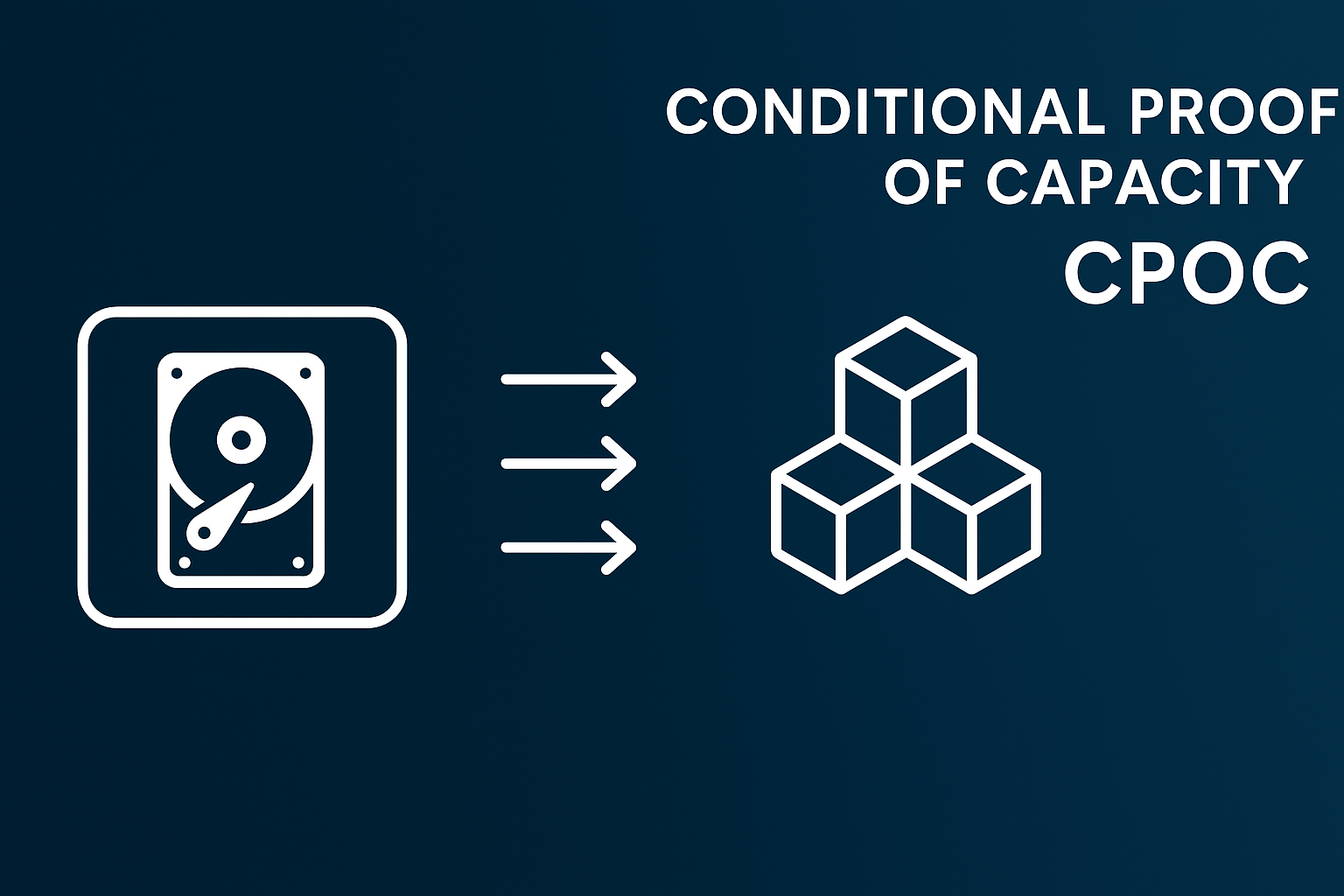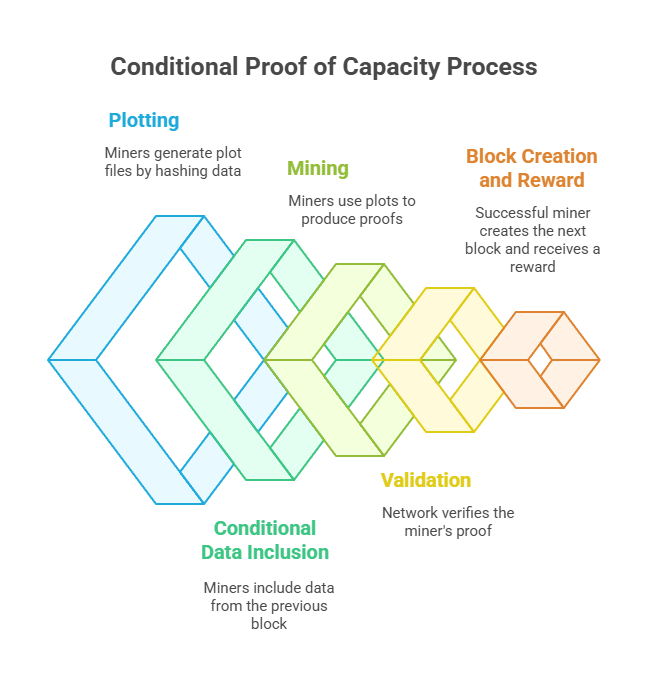CPOC Meaning
The Proof of Capacity (PoC) algorithm is improved by Conditional Proof of Capacity (CPOC), a sophisticated consensus mechanism created for blockchain networks. It seeks to enhance these networks’ decentralization and security. By using their available hard drive capacity, mining devices may validate transactions and create mining privileges to CPOC, a consensus protocol method. This method contrasts with Proof of Work (PoW) algorithms, which employ computational power, and Proof of Stake (PoS) methods, which use bitcoin holdings (stake).

CPOC Meaning
Understanding the Foundation: Traditional Proof of Capacity (PoC)
It’s useful to first comprehend CPOC’s predecessor, conventional Proof of Capacity (PoC), in order to completely appreciate it. A consensus process called PoC depends on miners allocating storage space for the purpose of storing “plots,” or pre-computed cryptographic solutions. The miner with the best proof builds the next block after searching their plots. Due to its low processing requirements, this technique utilises less energy than Proof of Work (PoW).
Signum (formerly Burstcoin) was the first real-world PoC blockchain system, founded in 2014. In PoC, miners use cryptographic methods to create random solutions (plots) beforehand, which are then stored on hard drives during a “plotting” phase that may take days or weeks, depending on storage capacity. The node with the quickest solution mines the next block during the “mining” stage that follows, in which miners compare their stored solutions to the most recent puzzle.
You can also read Understanding Cryptography Mechanisms In The Blockchain
The Innovation of CPOC: Adding a Conditional Component
By adding an essential conditional element to the evidence generation procedure, CPOC expands on the framework of PoC. This implies that miners must directly include certain information from the preceding block in their plot files. The main distinction that makes the consensus method more reliable and safe than conventional PoC algorithms is this extra criterion.
How Conditional Proof of Capacity Works

How Conditional Proof of Capacity Works
The operational flow of CPOC can be broken down into several key stages:
- Plotting: Miners set aside certain storage space to generate their plot files, much like in a typical proof of concept. This step involves repeatedly hashing data to create a list of all potential “nonce quantities,” including a miner’s account. After that, a lot of these hashes are combined into “scoops,” which are collections of two adjacent hashes.
- When it comes to conditional data inclusion, CPOC differs greatly from basic PoC. One important condition is that miners’ plot files have data from the previous block. This significantly reduces the difficulty for bad actors to fabricate schemes and control the network.
- Mining: Miners use their prepared plots to produce a proof whenever a new block is offered on the blockchain. The miner determines a “deadline” for each nonce that is stored. Then, out of all the computed deadlines, the miner chooses the nonce with the shortest deadline. A miner has a better probability of fitting the required hash value from their list and so obtaining the mining reward if they can store more possible solution values on their hard drive.
- Validation: Next, the network verifies the miner’s given proof. Particularly taking into account the conditional data from the prior block that was present in the miner’s plot file is a crucial component of this validation.
- Block Creation and Reward: The successful miner generates the subsequent block and gets the related reward if the proof is accepted as legitimate and no other miner has succeeded in forging a block within the allotted time.
You can also read What Is Pure Proof of Stake (PPoS)? Decentralized Blockchain
Key Features and Benefits of CPOC
CPOC offers blockchain networks several noteworthy benefits, including:
- Enhanced Security: Attackers find it far more difficult to fabricate plots or control the network when conditional data from the preceding block is required. The consensus process’s integrity is strengthened by this extra level of intricacy.
- Improved Decentralization: By making it more difficult for large-scale miners to control a network, CPOC helps to create a more decentralized system. These big miners would have to replot all of their storage if conditions changed, which would require a lot of resources. In the stage of processing cryptocurrencies, this also aids in lowering entrance barriers.
- Energy Efficiency: CPOC preserves PoC’s energy efficiency by using storage space instead of constant, high-intensity processing power. This makes it a greener consensus procedure than energy-intensive Proof of Work systems.
- Performance is one of the main reasons that CPOC systems are preferred over Proof of Work (PoW) and Proof of Stake (PoS) systems.
- Hybrid System Capability: CPOC functions somewhat like a cross between Proof of Stake (PoS), Proof of Work (PoW), and Proof of Capacity algorithms by combining aspects of a work, stake, and capacity system. Users may commit their digital assets in such a system in order to potentially obtain higher income incentives, and top users may be eligible for a new reward measure.
Addressing Challenges of Other Consensus Mechanisms
In order to overcome the well-known drawbacks of existing widely used consensus techniques, CPOC was developed as an alternative. It addresses the issue of cryptocurrency hoarding that can occur in Proof of Stake (PoS) systems as well as the excessive energy usage linked to Proof of Work (PoW) systems.
CPOC is essentially thought of as a major decentralization and security improvement over the current PoC method. With the goal of offering a more equitable and environmentally friendly substitute for mining, it produces a more strong and resilient consensus mechanism for blockchain networks.
You can also read Proof of Retrievability (PoR) And Proof of Storage Explained
